Junliang Xing
AFM-Net: Advanced Fusing Hierarchical CNN Visual Priors with Global Sequence Modeling for Remote Sensing Image Scene Classification
Oct 31, 2025Abstract:Remote sensing image scene classification remains a challenging task, primarily due to the complex spatial structures and multi-scale characteristics of ground objects. Existing approaches see CNNs excel at modeling local textures, while Transformers excel at capturing global context. However, efficiently integrating them remains a bottleneck due to the high computational cost of Transformers. To tackle this, we propose AFM-Net, a novel Advanced Hierarchical Fusing framework that achieves effective local and global co-representation through two pathways: a CNN branch for extracting hierarchical visual priors, and a Mamba branch for efficient global sequence modeling. The core innovation of AFM-Net lies in its Hierarchical Fusion Mechanism, which progressively aggregates multi-scale features from both pathways, enabling dynamic cross-level feature interaction and contextual reconstruction to produce highly discriminative representations. These fused features are then adaptively routed through a Mixture-of-Experts classifier module, which dispatches them to the most suitable experts for fine-grained scene recognition. Experiments on AID, NWPU-RESISC45, and UC Merced show that AFM-Net obtains 93.72, 95.54, and 96.92 percent accuracy, surpassing state-of-the-art methods with balanced performance and efficiency. Code is available at https://github.com/tangyuanhao-qhu/AFM-Net.
Hi-Agent: Hierarchical Vision-Language Agents for Mobile Device Control
Oct 16, 2025Abstract:Building agents that autonomously operate mobile devices has attracted increasing attention. While Vision-Language Models (VLMs) show promise, most existing approaches rely on direct state-to-action mappings, which lack structured reasoning and planning, and thus generalize poorly to novel tasks or unseen UI layouts. We introduce Hi-Agent, a trainable hierarchical vision-language agent for mobile control, featuring a high-level reasoning model and a low-level action model that are jointly optimized. For efficient training, we reformulate multi-step decision-making as a sequence of single-step subgoals and propose a foresight advantage function, which leverages execution feedback from the low-level model to guide high-level optimization. This design alleviates the path explosion issue encountered by Group Relative Policy Optimization (GRPO) in long-horizon tasks and enables stable, critic-free joint training. Hi-Agent achieves a new State-Of-The-Art (SOTA) 87.9% task success rate on the Android-in-the-Wild (AitW) benchmark, significantly outperforming prior methods across three paradigms: prompt-based (AppAgent: 17.7%), supervised (Filtered BC: 54.5%), and reinforcement learning-based (DigiRL: 71.9%). It also demonstrates competitive zero-shot generalization on the ScreenSpot-v2 benchmark. On the more challenging AndroidWorld benchmark, Hi-Agent also scales effectively with larger backbones, showing strong adaptability in high-complexity mobile control scenarios.
Goal-Oriented Skill Abstraction for Offline Multi-Task Reinforcement Learning
Jul 09, 2025Abstract:Offline multi-task reinforcement learning aims to learn a unified policy capable of solving multiple tasks using only pre-collected task-mixed datasets, without requiring any online interaction with the environment. However, it faces significant challenges in effectively sharing knowledge across tasks. Inspired by the efficient knowledge abstraction observed in human learning, we propose Goal-Oriented Skill Abstraction (GO-Skill), a novel approach designed to extract and utilize reusable skills to enhance knowledge transfer and task performance. Our approach uncovers reusable skills through a goal-oriented skill extraction process and leverages vector quantization to construct a discrete skill library. To mitigate class imbalances between broadly applicable and task-specific skills, we introduce a skill enhancement phase to refine the extracted skills. Furthermore, we integrate these skills using hierarchical policy learning, enabling the construction of a high-level policy that dynamically orchestrates discrete skills to accomplish specific tasks. Extensive experiments on diverse robotic manipulation tasks within the MetaWorld benchmark demonstrate the effectiveness and versatility of GO-Skill.
* ICML2025
Synergizing Reinforcement Learning and Genetic Algorithms for Neural Combinatorial Optimization
Jun 11, 2025Abstract:Combinatorial optimization problems are notoriously challenging due to their discrete structure and exponentially large solution space. Recent advances in deep reinforcement learning (DRL) have enabled the learning heuristics directly from data. However, DRL methods often suffer from limited exploration and susceptibility to local optima. On the other hand, evolutionary algorithms such as Genetic Algorithms (GAs) exhibit strong global exploration capabilities but are typically sample inefficient and computationally intensive. In this work, we propose the Evolutionary Augmentation Mechanism (EAM), a general and plug-and-play framework that synergizes the learning efficiency of DRL with the global search power of GAs. EAM operates by generating solutions from a learned policy and refining them through domain-specific genetic operations such as crossover and mutation. These evolved solutions are then selectively reinjected into the policy training loop, thereby enhancing exploration and accelerating convergence. We further provide a theoretical analysis that establishes an upper bound on the KL divergence between the evolved solution distribution and the policy distribution, ensuring stable and effective policy updates. EAM is model-agnostic and can be seamlessly integrated with state-of-the-art DRL solvers such as the Attention Model, POMO, and SymNCO. Extensive results on benchmark problems (e.g., TSP, CVRP, PCTSP, and OP) demonstrate that EAM significantly improves both solution quality and training efficiency over competitive baselines.
DeCoDe: Defer-and-Complement Decision-Making via Decoupled Concept Bottleneck Models
May 25, 2025Abstract:In human-AI collaboration, a central challenge is deciding whether the AI should handle a task, be deferred to a human expert, or be addressed through collaborative effort. Existing Learning to Defer approaches typically make binary choices between AI and humans, neglecting their complementary strengths. They also lack interpretability, a critical property in high-stakes scenarios where users must understand and, if necessary, correct the model's reasoning. To overcome these limitations, we propose Defer-and-Complement Decision-Making via Decoupled Concept Bottleneck Models (DeCoDe), a concept-driven framework for human-AI collaboration. DeCoDe makes strategy decisions based on human-interpretable concept representations, enhancing transparency throughout the decision process. It supports three flexible modes: autonomous AI prediction, deferral to humans, and human-AI collaborative complementarity, selected via a gating network that takes concept-level inputs and is trained using a novel surrogate loss that balances accuracy and human effort. This approach enables instance-specific, interpretable, and adaptive human-AI collaboration. Experiments on real-world datasets demonstrate that DeCoDe significantly outperforms AI-only, human-only, and traditional deferral baselines, while maintaining strong robustness and interpretability even under noisy expert annotations.
Exploring Reliable PPG Authentication on Smartwatches in Daily Scenarios
Mar 31, 2025
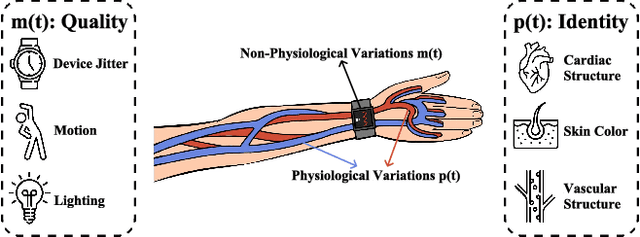

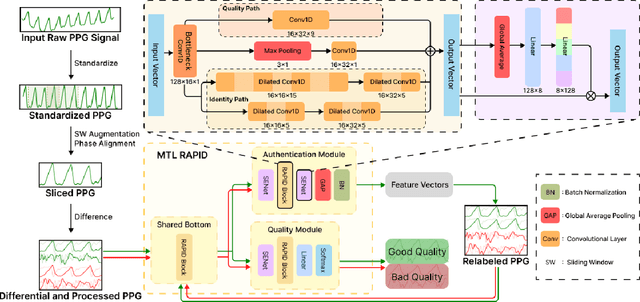
Abstract:Photoplethysmography (PPG) Sensors, widely deployed in smartwatches, offer a simple and non-invasive authentication approach for daily use. However, PPG authentication faces reliability issues due to motion artifacts from physical activity and physiological variability over time. To address these challenges, we propose MTL-RAPID, an efficient and reliable PPG authentication model, that employs a multitask joint training strategy, simultaneously assessing signal quality and verifying user identity. The joint optimization of these two tasks in MTL-RAPID results in a structure that outperforms models trained on individual tasks separately, achieving stronger performance with fewer parameters. In our comprehensive user studies regarding motion artifacts (N = 30), time variations (N = 32), and user preferences (N = 16), MTL-RAPID achieves a best AUC of 99.2\% and an EER of 3.5\%, outperforming existing baselines. We opensource our PPG authentication dataset along with the MTL-RAPID model to facilitate future research on GitHub.
GTR: Guided Thought Reinforcement Prevents Thought Collapse in RL-based VLM Agent Training
Mar 11, 2025Abstract:Reinforcement learning with verifiable outcome rewards (RLVR) has effectively scaled up chain-of-thought (CoT) reasoning in large language models (LLMs). Yet, its efficacy in training vision-language model (VLM) agents for goal-directed action reasoning in visual environments is less established. This work investigates this problem through extensive experiments on complex card games, such as 24 points, and embodied tasks from ALFWorld. We find that when rewards are based solely on action outcomes, RL fails to incentivize CoT reasoning in VLMs, instead leading to a phenomenon we termed thought collapse, characterized by a rapid loss of diversity in the agent's thoughts, state-irrelevant and incomplete reasoning, and subsequent invalid actions, resulting in negative rewards. To counteract thought collapse, we highlight the necessity of process guidance and propose an automated corrector that evaluates and refines the agent's reasoning at each RL step. This simple and scalable GTR (Guided Thought Reinforcement) framework trains reasoning and action simultaneously without the need for dense, per-step human labeling. Our experiments demonstrate that GTR significantly enhances the performance and generalization of the LLaVA-7b model across various visual environments, achieving 3-5 times higher task success rates compared to SoTA models with notably smaller model sizes.
Dynamic Dictionary Learning for Remote Sensing Image Segmentation
Mar 09, 2025Abstract:Remote sensing image segmentation faces persistent challenges in distinguishing morphologically similar categories and adapting to diverse scene variations. While existing methods rely on implicit representation learning paradigms, they often fail to dynamically adjust semantic embeddings according to contextual cues, leading to suboptimal performance in fine-grained scenarios such as cloud thickness differentiation. This work introduces a dynamic dictionary learning framework that explicitly models class ID embeddings through iterative refinement. The core contribution lies in a novel dictionary construction mechanism, where class-aware semantic embeddings are progressively updated via multi-stage alternating cross-attention querying between image features and dictionary embeddings. This process enables adaptive representation learning tailored to input-specific characteristics, effectively resolving ambiguities in intra-class heterogeneity and inter-class homogeneity. To further enhance discriminability, a contrastive constraint is applied to the dictionary space, ensuring compact intra-class distributions while maximizing inter-class separability. Extensive experiments across both coarse- and fine-grained datasets demonstrate consistent improvements over state-of-the-art methods, particularly in two online test benchmarks (LoveDA and UAVid). Code is available at https://anonymous.4open.science/r/D2LS-8267/.
StickMotion: Generating 3D Human Motions by Drawing a Stickman
Mar 05, 2025Abstract:Text-to-motion generation, which translates textual descriptions into human motions, has been challenging in accurately capturing detailed user-imagined motions from simple text inputs. This paper introduces StickMotion, an efficient diffusion-based network designed for multi-condition scenarios, which generates desired motions based on traditional text and our proposed stickman conditions for global and local control of these motions, respectively. We address the challenges introduced by the user-friendly stickman from three perspectives: 1) Data generation. We develop an algorithm to generate hand-drawn stickmen automatically across different dataset formats. 2) Multi-condition fusion. We propose a multi-condition module that integrates into the diffusion process and obtains outputs of all possible condition combinations, reducing computational complexity and enhancing StickMotion's performance compared to conventional approaches with the self-attention module. 3) Dynamic supervision. We empower StickMotion to make minor adjustments to the stickman's position within the output sequences, generating more natural movements through our proposed dynamic supervision strategy. Through quantitative experiments and user studies, sketching stickmen saves users about 51.5% of their time generating motions consistent with their imagination. Our codes, demos, and relevant data will be released to facilitate further research and validation within the scientific community.
DiffBrush:Just Painting the Art by Your Hands
Feb 28, 2025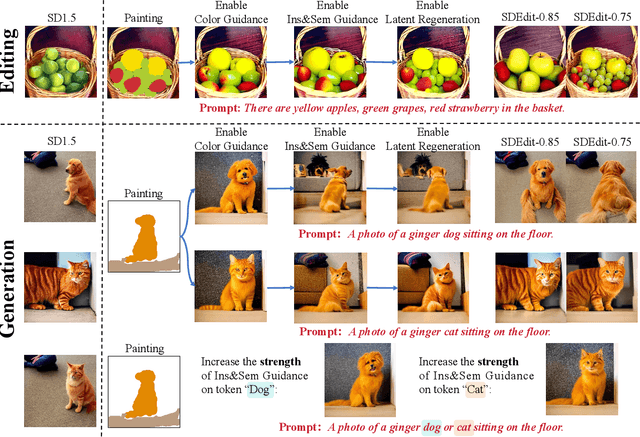

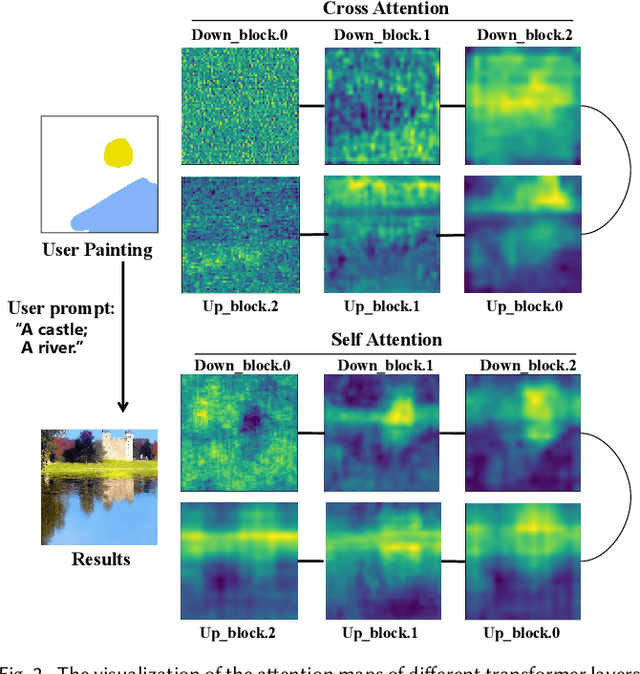
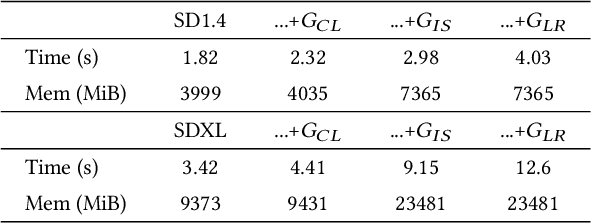
Abstract:The rapid development of image generation and editing algorithms in recent years has enabled ordinary user to produce realistic images. However, the current AI painting ecosystem predominantly relies on text-driven diffusion models (T2I), which pose challenges in accurately capturing user requirements. Furthermore, achieving compatibility with other modalities incurs substantial training costs. To this end, we introduce DiffBrush, which is compatible with T2I models and allows users to draw and edit images. By manipulating and adapting the internal representation of the diffusion model, DiffBrush guides the model-generated images to converge towards the user's hand-drawn sketches for user's specific needs without additional training. DiffBrush achieves control over the color, semantic, and instance of objects in images by continuously guiding the latent and instance-level attention map during the denoising process of the diffusion model. Besides, we propose a latent regeneration, which refines the randomly sampled noise in the diffusion model, obtaining a better image generation layout. Finally, users only need to roughly draw the mask of the instance (acceptable colors) on the canvas, DiffBrush can naturally generate the corresponding instance at the corresponding location.
 Add to Chrome
Add to Chrome Add to Firefox
Add to Firefox Add to Edge
Add to Edge